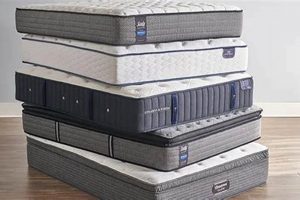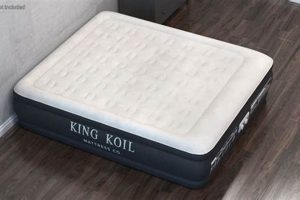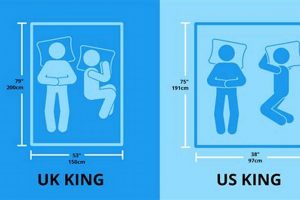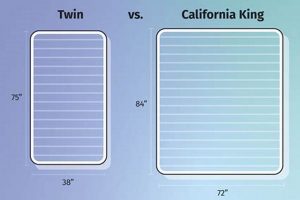A specific mattress dimension tailored for recreational vehicles, these mattresses typically measure around 72 inches wide and 80 inches long. This contrasts with standard king mattresses, which are wider. Such dimensions are necessitated by the space constraints common in RVs, offering a comfortable sleeping arrangement while maximizing usable area within the vehicle. A comparable example would be a residential king size split into two Twin XL beds.
The benefit lies primarily in optimizing space utilization within the confines of a recreational vehicle. Choosing the appropriate size ensures ease of movement, storage, and overall comfort. Before the standardization of RV components, custom-made mattresses were the norm, leading to inconsistencies and difficulties in replacement. The advent of specific sizes simplifies the purchasing process and allows for a wider range of bedding options.
Understanding dimensions is crucial for choosing the correct bedding and ensuring a restful sleep while traveling. The subsequent sections will delve into specific considerations for selecting an appropriate mattress, explore various mattress types suitable for RVs, and provide guidance on measuring the available space accurately.
RV King Mattress Size
Selecting the correct mattress dimensions for a recreational vehicle requires careful consideration to ensure both comfort and efficient use of available space. The following tips outline key factors to consider when choosing a suitable mattress.
Tip 1: Measure Available Space Accurately: Before purchasing, meticulously measure the sleeping area within the RV. Consider any obstructions or irregularities in the space that may affect mattress placement. Accurate measurements are crucial for avoiding fitment issues.
Tip 2: Consider Mattress Thickness: Be mindful of the mattress’s thickness. A thicker mattress may provide greater comfort but could restrict headroom or make accessing overhead storage more challenging. Evaluate the trade-off between comfort and spatial constraints.
Tip 3: Evaluate Mattress Material Options: Different materials, such as memory foam, innerspring, or latex, offer varying levels of support and temperature regulation. Research the properties of each material to determine which best suits individual sleeping preferences and climate conditions.
Tip 4: Assess Weight Considerations: The weight of the mattress can impact the overall weight distribution of the RV. Lighter materials may be preferable to minimize fuel consumption and ensure compliance with weight restrictions.
Tip 5: Prioritize Breathability: RVs can be prone to temperature fluctuations and humidity. Opt for mattresses with breathable materials or cooling technologies to promote airflow and prevent overheating during sleep.
Tip 6: Check Compatibility with Bed Frame: Verify that the chosen mattress is compatible with the existing bed frame or platform in the RV. Some frames may require specific mattress types or support systems.
Proper mattress selection based on its dimensions directly influences sleep quality, interior space efficiency, and overall comfort within the recreational vehicle. Adhering to these guidelines will improve the RV experience.
The subsequent sections will explore common errors in mattress selection and provide strategies for maximizing space utilization within the RV sleeping area.
1. Width
The specific width of seventy-two inches is a defining characteristic of the designation “rv king mattress size.” This dimension differentiates it from a standard king mattress, which typically measures seventy-six inches in width. The reduced width is a direct adaptation to the spatial limitations inherent in most recreational vehicles. Failing to adhere to this specification would likely result in the mattress not fitting properly within the designated sleeping area of the RV, rendering it unusable or requiring modifications to the vehicle’s interior. A real-life example might involve attempting to install a standard king mattress into an RV bedroom, discovering the incompatibility due to the excessive width, and consequently needing to return the mattress or undertake costly structural alterations. The practical significance lies in ensuring a comfortable sleep surface without compromising maneuverability and storage capacity inside the RV.
The consequences of ignoring the seventy-two-inch width parameter extend beyond mere fitment issues. An oversized mattress can obstruct walkways, impede access to storage compartments, and generally diminish the usability of the RV’s living space. Furthermore, forcing a larger mattress into a confined area can lead to premature wear and tear on both the mattress and the surrounding structures. Consider an RV with slide-outs: an improperly sized mattress may interfere with the smooth operation of the slide-out mechanism, potentially causing damage and requiring expensive repairs. Therefore, understanding and respecting this dimension is paramount for maintaining the functionality and longevity of both the mattress and the recreational vehicle.
In summary, the seventy-two-inch width is not merely an arbitrary measurement but a crucial component that defines “rv king mattress size” and ensures its suitability for the intended environment. Overlooking this aspect can lead to practical problems and compromises in comfort and space utilization. Awareness and adherence to these dimensional constraints are vital for optimizing the RV experience and ensuring a comfortable and functional mobile living space.
2. Length
The eighty-inch length is a standardized dimension directly correlating to recreational vehicle king mattress specifications. This length is often dictated by the pre-existing bed frames and sleeping area configurations found within RV models. Deviating from this standardized length, by attempting to use a mattress exceeding eighty inches, will likely result in an improper fit, potentially requiring modification to the RV’s structure or rendering the mattress unusable. For example, installing an eighty-four-inch-long mattress into a space designed for an eighty-inch mattress will cause the mattress to bend or compress against the walls, reducing sleeping comfort and potentially damaging the surrounding structures. Therefore, the eighty-inch length is a non-negotiable component in maintaining compatibility and usability within the context of an RV.
The practical applications of understanding the importance of length are numerous. It directly affects the selection of appropriate bedding, such as sheets and mattress protectors. Incorrectly sized bedding will bunch up, tear, or not fit at all, leading to discomfort and premature wear. Furthermore, knowledge of the correct length is critical when custom-ordering mattresses. RV owners who require specialized mattresses due to medical needs or personal preferences must provide accurate dimensions to ensure a proper fit. Pur
chasing a custom mattress with an incorrect length negates the benefits of customization, resulting in wasted resources. A person requiring a special mattress due to back problems would require correct length for the best support.
In summary, the eighty-inch length is integral to the concept of “rv king mattress size,” and it ensures conformity and practicality. While variations might exist in thickness or material, adherence to the prescribed length is vital for compatibility within the RV environment. Ignoring this fundamental dimension results in unnecessary complications and compromises the overall comfort and functionality of the sleeping area.
3. Thickness Variability
Thickness variability in mattresses directly relates to the overall utility of the “rv king mattress size” within a recreational vehicle. While the length and width adhere to specific dimensions to ensure fitment, thickness is more variable, contingent upon material composition and intended comfort level. This variation can significantly impact headroom, storage space accessibility above the sleeping area, and overall ease of movement within the confined space. Selecting a thicker mattress may enhance comfort for some individuals, but it reduces vertical space, potentially creating a feeling of confinement. Conversely, a thinner mattress, while conserving space, may compromise support and long-term sleeping comfort. The consideration of thickness, therefore, represents a critical trade-off within the broader framework of recreational vehicle design and usability.
The practical implications of this variability extend to the specific selection of bedding and the need for customized solutions. Standard-depth sheets may not adequately fit thinner mattresses, leading to bunching and discomfort. Similarly, thicker mattresses may require deep-pocket sheets, which can be more costly and less readily available. Furthermore, the weight of the mattress, which is directly influenced by its thickness and material density, affects the vehicle’s overall fuel efficiency and stability. A heavier mattress can contribute to increased fuel consumption and a higher center of gravity, impacting handling characteristics. Consider a scenario where an RV owner replaces a standard mattress with a thicker, memory foam variant: The added weight and reduced headroom may necessitate adjustments to storage configurations and potentially reduce overall travel range.
In conclusion, thickness variability is an indispensable element of “rv king mattress size,” demanding careful consideration of spatial constraints, comfort preferences, and practical concerns related to vehicle dynamics. While the dimensions of length and width are largely fixed, the selection of an appropriate thickness represents a crucial decision point in optimizing the sleeping environment and ensuring compatibility within the recreational vehicle’s interior. A balanced approach, weighing the benefits of enhanced comfort against the potential drawbacks of reduced space and increased weight, is essential for maximizing the utility and enjoyment of the RV experience.
4. Frame Compatibility
Frame compatibility is a crucial, often overlooked, aspect of selecting a mattress designed for recreational vehicles. An incorrectly sized or incompatible mattress frame can negate the benefits of a properly sized mattress, leading to discomfort, structural damage, and inefficient space utilization.
- Dimensional Precision
The precise dimensions of the RV king mattress size (72 inches by 80 inches) are predicated on the assumption of a compatible frame. If the frame is undersized, the mattress will be compressed, leading to premature wear and reduced comfort. Conversely, an oversized frame will allow the mattress to shift and sag, creating uneven support and potential safety hazards. An example would be a platform bed with internal dimensions of 71 inches by 79 inches, which is too small for the specified mattress.
- Support Structure Integrity
The frame’s support structure must be adequate to support the weight and dimensions of the RV king mattress. Insufficient support can cause the mattress to deform over time, negating its ergonomic benefits and potentially damaging the frame itself. A common scenario involves using a lightweight frame with inadequate cross-supports, resulting in sagging and uneven weight distribution across the mattress surface.
- Material Composition
The material composition of the frame influences its ability to accommodate the RV king mattress. Wooden frames, while aesthetically pleasing, may be prone to warping or cracking under significant weight or moisture exposure. Metal frames offer greater durability but may require additional padding to prevent slippage and noise. The material should therefore match the expected conditions inside the recreational vehicle to maximize longevity.
- Attachment Mechanisms
The method by which the mattress is secured to the frame is also important. Some frames incorporate retaining bars or straps to prevent movement during travel. A loose or unsecured mattress can shift during transit, posing a safety risk and potentially causing damage to the vehicle’s interior. It may be important to consider how a mattress may need to be secured for any travel that may occur.
Failure to address frame compatibility when selecting an RV king mattress can lead to a cascade of problems, diminishing the overall comfort and functionality of the sleeping area. Attention to the factors will significantly impact the sleep and safety of all occupants. Accurate frame and mattress measurements, combined with a careful assessment of the frame’s structural integrity and material composition, are essential for optimizing the RV experience.
5. Weight Distribution
The dimensions of a recreational vehicle king mattress are directly related to the overall weight distribution within the vehicle. The mattress dimensions (typically 72 inches wide by 80 inches long) determine its surface area, and when combined with material density, the total weight exerted on the underlying support structure. Improper weight distribution due to an inadequately sized or excessively heavy mattress can compromise the vehicle’s handling characteristics, increase fuel consumption, and accelerate wear on suspension components. For instance, an excessively dense memory foam mattress, while providing comfort, may concentrate a significant amount of weight in a single area of the RV, potentially leading to uneven settling or structural stress over time. This effect is compounded if the mattress is positioned off-center, further exacerbating weight imbalances.
The selection of appropriate mattress materials plays a crucial role in mitigating weight distribution issues. Lighter materials, such as latex or specific types of foam, can provide adequate support without significantly increasing the overall weight load. In contrast, traditional innerspring mattresses, while relatively affordable, tend to be heavier and may contribute to weight imbalances. Furthermore, the positioning of storage compartments and other heavy items within the RV should be carefully
considered in relation to the mattress’s location. A balanced distribution of weight across the vehicle’s axles is essential for maintaining stability and preventing premature wear on tires and suspension systems. Consider a scenario where a heavy water tank is situated on the same side of the RV as a dense mattress: This uneven distribution of weight can result in increased tire wear on one side and potentially compromise braking performance.
In summary, the relationship between mattress dimensions, material composition, and overall weight distribution within a recreational vehicle is critical for ensuring safe and efficient operation. Selecting an RV king mattress that aligns with the vehicle’s weight capacity and promotes a balanced distribution of weight is essential for optimizing handling characteristics, minimizing wear and tear, and enhancing the overall RV experience. The challenge lies in balancing comfort preferences with the practical considerations of weight management and vehicle dynamics. Adherence to manufacturer’s weight limits and careful consideration of material choices are crucial for mitigating potential risks and maximizing the longevity of the recreational vehicle.
Frequently Asked Questions
The following questions address common inquiries and clarify important aspects of RV king mattress dimensions and their impact on recreational vehicle use.
Question 1: What are the exact dimensions that define “RV king mattress size”?
An RV king mattress is typically defined as measuring approximately 72 inches in width and 80 inches in length. Deviations from these dimensions can cause fitment issues within the RV’s sleeping area.
Question 2: How does an RV king mattress differ from a standard residential king mattress?
A standard residential king mattress is wider, generally measuring 76 inches in width, compared to the RV king’s 72 inches. This difference accommodates the reduced space typically available in recreational vehicles.
Question 3: What considerations are important when selecting the thickness of an RV king mattress?
Thickness affects headroom, access to overhead storage, and overall comfort. A balance must be struck between comfort and spatial constraints within the RV.
Question 4: How does mattress weight affect RV performance and fuel efficiency?
A heavier mattress increases the overall weight of the RV, potentially impacting fuel consumption and handling characteristics. Lighter materials are generally preferable.
Question 5: Is it possible to use a standard residential king mattress in an RV?
While technically possible in some instances, it is generally not recommended due to the width difference. Attempting to force a larger mattress into a smaller space can cause damage and discomfort.
Question 6: Where can one acquire an RV king mattress?
These mattresses are available through specialized RV supply stores, online retailers, and some mattress manufacturers that offer custom sizing options.
Understanding these critical aspects of RV king mattress dimensions ensures a comfortable sleeping environment and maximizes the functionality of the recreational vehicle.
The subsequent section will discuss common mistakes to avoid when choosing an RV mattress and provide additional resources for further research.
Conclusion
The preceding analysis underscores the nuanced considerations inherent in selecting an RV king mattress. The dimensions, material composition, frame compatibility, and weight distribution each play a pivotal role in optimizing both comfort and the overall functionality of a recreational vehicle. Ignoring any of these factors can lead to compromised sleep quality, inefficient space utilization, and potential damage to the vehicle’s structure. While comfort remains a primary concern, practical considerations related to weight, space, and compatibility are equally critical. Accurate measurement and awareness of vehicle specifications are essential for informed decision-making.
The prudent selection of RV king mattress size, therefore, transcends mere personal preference. It represents an investment in safety, comfort, and the longevity of the recreational vehicle. Further research, including consultation with experienced RV professionals and a thorough assessment of individual needs and vehicle specifications, is strongly encouraged. The impact of choosing the correct mattress extends beyond nightly rest; it influences the overall travel experience and the value derived from the investment in a recreational vehicle.







